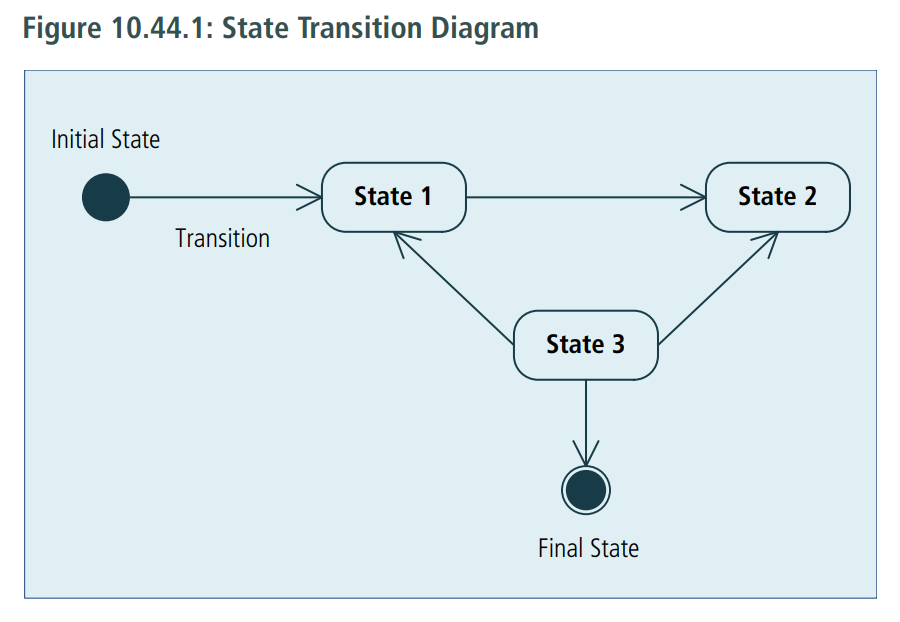10.44.1 Purpose
State modelling is used to describe and analyze the different possible states of an entity within a system, how that entity changes from one state to another, and what can happen to the entity when it is in each state.
10.44.2 Description
An entity is an object or concept within a system. An entity may be used in several processes. The life cycle of every entity has a beginning and an end.
In a state model (also sometimes called a state transition model), a state is a formal representation of a status. It is used when it is necessary to have a precise and consistent understanding of an entity that has complex behavior and complex rules about that behavior.
A state model describes:
- a set of possible states for an entity,
- the sequence of states that the entity can be in,
- how an entity changes from one state to another,
- the events and conditions that cause the entity to change states, and
- the actions that can or must be performed by the entity in each state as it moves through its life cycle.
While a process model can show all of the entities that are used in or affected by that process, a state model shows a complementary view: what happens to one entity across all the processes that affect it or use it.
10.44.3 Elements
.1 State
An entity has a finite number of states during its life cycle, although it can be in more than one state at a time. Each state is described with a name and the activities that could be performed while in that state. There may be rules about which activities must or can be performed and which events it can respond to or trigger.
A complex state can be decomposed into sub-states.
.2 State Transition
How the entity changes or transitions from one state to another could be determined by the steps of a process, by business rules, or by information content. The sequence of states of an entity are not always linear; an entity could skip over several states or revert to a previous state, perhaps more than once.
A transition may be conditional (triggered by a specific event or a condition being reached) or automatic (triggered by the completion of the required activities while in the previous state or by the passage of time). It may also be recursive, leaving one state and returning back to the same state. A transition is described in terms of the event that causes the transition, conditions which determine whether or not the entity must respond to that event, and actions that occur in association with the event.
.3 State Diagram
A state diagram shows the life cycle of one entity, beginning when the entity first comes into existence and moving through all of the different states that the entity may have until it is discarded and no longer of use.
A state on a state diagram is shown as a rectangle with rounded corners. There may be any number of states. A state may be decomposed into sub-states.
The transition from one state to another state is shown with a one-directional arrow pointing from the start state to the destination state, optionally labelled with the name of the event that causes the entity’s state to change from one state to another, and optionally with conditions and actions.
The beginning and end of the entity’s life cycle are shown with special symbols for both the initial state, which indicates that the entity has come into existence, and the final state, which indicates that the entity is discarded and the life cycle is complete.

.4 State Tables
A state table is a two-dimensional matrix showing states and the transitions between them. It can be used during elicitation and analysis either as an alternative, a precursor, or a complement to a state diagram. It is a simple way to get started on a state model in order to elicit the state names and event names from the domain subject matter experts.
Each row shows a starting state, the transition, and the end state. If one state could respond to several transitions, there will be a separate row for each transition.
A state that appears as an end state in one row could be a start state in another row.
10.44.4 Usage Considerations
.1 Strengths
- Identifies business rules and information attributes that apply to the entity being modelled.
- Identifies and describes the activities that apply to the entity at different states of the entity.
- Is a more effective documentation and communication tool than plain text, especially if the entity being described has more than a few states, transitions, and conditions governing those transitions.
.2 Limitations
- Is usually only used to understand and communicate about information entities that are perceived to be complex; simple entities may be understood without the time and effort required to build a state model.
- Building a state model appears simple at the start, but achieving a consensus among domain SMEs about the details required by the model can be difficult and time-consuming.
- A high degree of precision about states and transitions is required to build a state diagram; some domain SMEs and business analysis practitioners are uncomfortable trying to describe such a level of detail.
